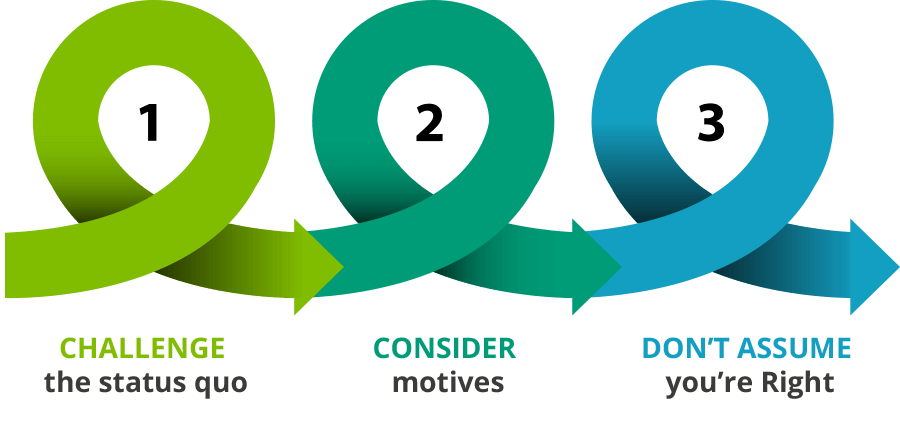With the rise of automation, comes the rise of soft skills. The landscape of work is shifting; and in order to keep up with the change, workers will need to develop competencies that machines won’t tackle. In this series we talk about the top 10 soft skills that will help you to thrive in 2020. And today’s skill is critical thinking.
What is Critical Thinking?
Critical thinking is the process of actively analyzing, applying, and evaluating information generated by experience, communication, or observation as a guide to belief and action. Critical thinking is the deliberate processing of information aimed at making better decisions. Regular, everyday thinking is different from critical thinking as it’s often based on stereotypical understandings of our behaviors, assumptions, and habits.
Exercising critical thinking allows one to understand the connections between ideas, prioritize tasks, identify errors in reasoning, and have a systematic approach to problem-solving. The deliberate application of the following four habits can help you to improve your critical thinking skills.

Explore a Question
The ability to ask questions can result in unexpected results as it can steer the conversation into a new dimension and lead to a different outcome. Asking questions allows you to expand your view of the problem and challenge assumptions. In addition to asking the “Why?” and “Why not?” questions that help get to the root of the motive, consider the four types of questions. Clarifying, Adjoining, Funneling, and Elevating — each focusing on achieving a different goal.
4 Types of Questions

Clarifying questions allow you to uncover the real intention behind an action or what is said. “Could you elaborate on X?” and “Why do you think so?” can help fill in the missing pieces of the puzzle and make the bigger picture complete. People often neglect these types of questions as they think their assumptions are true.
Adjoining questions allow you to shift the focus from one problem to a similar one to gain a better understanding of all the variables. Questions like, “How would this work in a different country?” and “What are the related applications of this technology?” allow you to explore more options and broaden your understanding of a problem at hand. By tweaking one of the variables and considering the change in outcome you are able to see the cause-effect relationship.
Funneling questions are meant to help dig deeper. They are targeted at understanding the methodology one uses to come to a conclusion. “Why did you include this step in the plan?” “How did you analyze the results?” Funneling questions aim to take apart the procedure in order to see what can be improved.
Elevating questions touch upon broader issues and help paint a bigger picture. Questions like “Let’s take a step back. What is the bigger problem here?” and “Have we got sidetracked from the focus of our conversation?” Elevating questions help to change the focus from details to a bigger picture and to see the links between individual problems.
Manage an Ordered List

Ensuring that the problems at hand get the attention they deserve can be achieved by organizing tasks in the order of their importance. The process of prioritizing allows you to take into consideration the urgency, importance, impact, and intellectual resources it’ll take to tackle the task. For example, things like printouts, notebooks and calendar apps will help you track your to-do items and clear your head to ensure a higher decision-making capacity.
In addition to finding a method to keep track of tasks that works for you, remember the core principles:
- Write down every idea you come up within a designated app/notebook that acts as the “Inbox” for your thoughts. A good resource to consult on this method would be Getting Things Done, a book by David Allen.
- Find links between the short-term and long-term goals that you are setting
- Tackle both personal and business goals throughout the day in order to diversify your attention and feel in control of your life in general.
If you prefer to track your tasks the old-school pen-and-paper way, consider applying the Kanban method and the good old Eisenhower matrix. As for digital tools, look into Trello, Todoist, and Google Calendar.
Recognize a Weakness and Improve it

It would be ideal if we were good at everything, however, in reality we all have a set of unique strengths and weaknesses. And although your strengths are what determine your professional expertise, working on your weaknesses can open up opportunities for development in related fields. The first step towards working on your weaknesses is recognizing them. One way to get a full picture of your traits is to ask your coworkers who see you in the working environment.
Alternatively, you can take a Personality strengths test which will give you a list of 24 strengths in descending order. The test is a series of questions which ask you to choose your personal reaction to a given situation. The top third of the strengths is the skills that best describe your personality. And the last eight traits are skills that come less naturally and require more effort to use.
Solve a Problem in Your Life
Sometimes facing a problem can get overwhelming. Not knowing where to start and how to outline the action plan can hinder you from taking any action at all. Critical thinkers approach problems as challenges; and to provide a framework for action, you can use the Solution Fluency process. There are six stages that are conveniently called “6 Ds”:
Define what needs to be solved and provide the context to the problem.
Discover background information on the issue by researching and analyzing information.
Dream about all the ways to solve the problem to reach the result you want.
Design the actual procedure so that your idea comes to life.
Deliver the final product or present the potential solution.
Debrief and look back at the steps and actions that brought you closer to success and the ones that hindered you so that you can improve your approach in the future.
Points to Consider When Practicing Critical Thinking

- Challenge the status quo. Question traditional ways to approach a problem. Find an alternative way to optimize time and implement new techniques to get the right result in less time.
- Consider Motives. As a rule of thumb, when someone offers you something, they need you to agree. Take a break and don’t give an answer right away, consider the motives the person might pursue. Consider your history with the person and ask, “What’s in it for them?”
- Don’t Assume You’re Right. Sometimes we can accept a faulty idea because no one has challenged it before. Be open to alternative lines of reasoning and compare other points of view with yours. Instead of assuming you’re right, be ready to operate with numbers and cases to prove your point.
Additional Resources
Additionally, to improve your ability to analyze data as well as learn basic concepts from cognitive psychology and cost-benefit theory, take this Mindware: Critical Thinking for the Information Age Course from the University of Michigan. The Critical Thinking Skills for University Success Course from the University of Sydney will guide you through techniques to improve your academic results. The course covers thinking tools to improve critical thinking and ways to identify bias withing arguments.
Critical thinking is a transferrable skill that allows you to improve the quality of the decisions you make. Applying this skill in different settings is the key to approaching problems in a systematic way.
Check out the article on Complex Problem Solving!
Photos: Shutterstock, Martina Advaney / Edited by: Martina Advaney
Support us!
All your donations will be used to pay the magazine’s journalists and to support the ongoing costs of maintaining the site.
Share this post
Interested in co-operating with us?
We are open to co-operation from writers and businesses alike. You can reach us on our email at [email protected]/[email protected] and we will get back to you as quick as we can.










